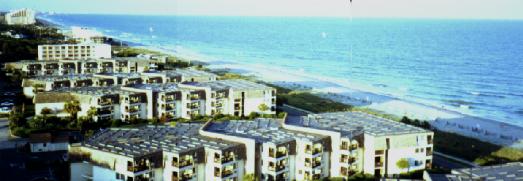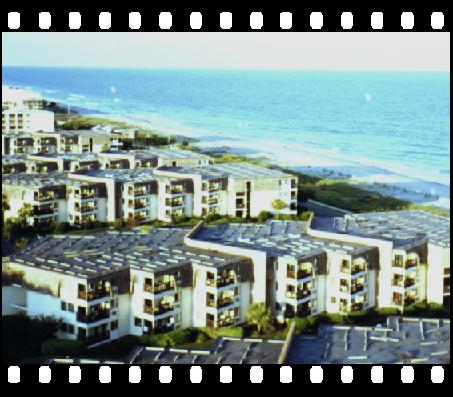
65mm film negatives with no sound lines would be used in the camera to shoot the footage.

For the release they would transfer the image to 70mm film stock with 6 channels of sound.

Before "Flat" (Spherical Matted) and "Scope" (Panavision) became the standard many companies came up with different ways to make wide screen films. Many of these "Gimmick" formats did not yield great increases in profits because most theaters would not buy the equipment to exhibit those films. The movie Studios had to transfer their "Gimmick" films to standard 35mm to get them shown in most markets. Of course, if you're mostly showing it in standard 35mm what was the point of spending all of the extra money on the special format in the first place.


Vista-Vision is a horizontal 35mm system. The horizontal frames were 1.66x1 but an anamorphic lens could be used to compress an image at 1.85x1 or 1.96x1. It required special cameras to shoot and special projectors to show a Vista-Vision film. Alfred Hitchcock used Vista-Vision to shoot Vertigo, To Catch a Thief, and North by Northwest. The problem was that most movie theaters were not willing to spend all of the money required to exhibit Vista-Vision movies, a 35mm film projector is a VERY expensive piece of equipment. In fact many Vista-Vision pictures would be shown in Vista-Vision in only a few select theaters (which were usually in New York and LA) and than they would be transferred to standard 35mm for all the other theaters.
In 1977 George Lucas brought Vista-Vision out of retirement for use in his special effects sequences in Star Wars. He wanted to have outer space effects with multiple spacecraft moving independently of each other. The problem is that each element of the picture must be shot separately of the others. If he were to shot an outer space shot with a planet in the background, an X-Wing and 2 TIE fighters shooting at each other it would require combining 6 different pieces of film.
1. The star field background
2. The planet
3. The X-Wing
4. One of the TIE fighters
5. The other TIE fighter
6. The laser beams
In order to combine all of these shots the separate elements of film would have to be copied and re-copied multiple times. Every time they copy the film the picture quality suffers. After so many copies a standard 35mm image is well below acceptable levels. A Vista-Vision image, on the other hand, will end up well below Vista-Vision quality but will look just fine when transferred to standard 35mm. For years movies like Star Wars, Apollo 13, & Starship Troopers have used Vista-Vision to shoot their special effects scenes.
Technirama is basically Technicolor's version of Vista-Vision. Disney's Sleeping Beauty was made in Technirama (at a ratio of 2.20x1), but since most theaters were not set up for it Disney had to transfer it to standard 35mm for most of the release. The 35mm prints were at a ratio of 2.35x1 which means that part of the top and bottom of the picture was lost.
Another way to get a sharper picture is to use a larger film stock. 70mm film is twice as wide as 35mm, meaning that the image will be sharper. 70mm also had 6 channels of stereo sound, at that time 35mm would use ether mono (1 channel) or 2 channel stereo. 70mm films were generally shot on 65mm negatives (because they had no sound lines). For their released they would transfer the image to 70mm with 6 channels of sound. 6 channel 70mm film frames are 2.20x1 if an anamorphic lens is not used. If an anamorphic lens is used the sky is the limit.
35mm has much less surface area than 70mm.

65mm film negatives with no sound lines would be used in the camera to shoot the footage.

For the release they would transfer the image to 70mm film stock with 6 channels of sound.

Todd-AO was the main 70mm format. Many of the great musicals of the 60s (Oklahoma, South Pacific and Around the World in 80 Days) were shot in Todd-AO at a ratio of 2.20x1. 2001: A Space Odyssey, Dune and Logans Run were shot using an anamorphic lens to make the the image 2.35x1. As with Vista-Vision many theaters could not show Todd-AO films and the movie would have to be transferred to standard 35mm film for it's general release (which also meant the loss of the 6 channel stereo sound).
Ultra Panavision 70 used 70mm film and an anamorphic lens to capture an image that was 2.76x1 . Ben-Hur and Raintree County were the only 2 films ever shot at in a ratio of 2.76x1. No other 70mm films were ever shot at so wide of a ratio because transfering the movie to standard 35mm (not to mention TV) required such a large amount of the picture to be cut off.
Using an anamorphic lens on 70mm can give you the widest single film ratio. Notice that the image is slightly squeezed together on the film


Cinerama was what you could call the precursor to today's IMAX experience. It was the widest picture that you could get. A movie would be shot with 3 cameras sitting side by side. These 3 film images could than be projected onto a curved screen by 3 projectors running side by side. These films could be shot in the ratios of 2.59x1, 2.68x1, 2.77x1 How the West Was Won was shot with this process. Of course this Cinerama experience could only be seen in special Cinerama theaters, and they were few and far between. Another problem is that since the image is coming from 3 separate strips of film their were slight lines in the image, no matter how carefully everything was aligned. How the West Was Won was transferred to standard 35mm for a general release. Cinerama was also the first format to have 7 channels of sound.



Since Cinerama was very difficult and expensive to shoot in some people started using anamorphic 70mm and calling it "70mm Cinerama". It was not "true Cinerama" because only one projector and one camera was used. The 70mm film blew up to fill the Cinerama screen without showing too much grain, but it was not as sharp as true 3x35mm Cinerama. 2001: A Space Odyssey was shown in some Cinerama theaters.
The Imax corporation came up with the largest single film format yet. They took 70mm film and turned it horizontally. This made the frame 15 sprocket holes wide, which means 3 times more surface area than vertical 70mm. Imax films are shot on horizontal 65mm film with on sound lines and transfered to 70mm for their releases. Imax screens are huge and can give you the experience of "really being their" (even more so if it is Imax 3D.) With all of this surface area it costs a fortune to just buy enough 70mm film to shoot a 45minute short. Imax cameras are heavy and hard to move and set up. The screen is slightly curved around the edges to make up for the curvature of the lens. Imax projectors also have a different system of moving the film through the lens assemble than regular projectors. Their system moves the film more smoothly than the other systems because on a 7 story screen if the film shakes even a millimeter it will be quite jarring on the screen.
Imax theaters started out mostly in museums and science centers that showed mostly 45 minute educational documentaries. During the 90s Imax started branching out and formed partnerships with Sony, Regal Cinemas, and several other exhibitors. They partnered with the Walt Disney company and made the first feature length (meaning over and hour long) large-format movie Fantasia 2000.

A Horizontal 70mm Imax frame is so large that it dwarfs 35mm and has 3 times the area of vertical 70mm frame


Imax theaters have also taken vertical 70mm prints of movies like Titanic and The Perfect Storm and shown them on the Imax screen. When blown up onto a large screen these movies lack the sharpness of movies that were shot on horizontal 70mm like Everest and Special Effects: Anything Can Happen. For an example of this drop in quality check out how much more grain is in The Sorcerer's Apprentice section of Fantasia 2000 as compared to the rest of the movie. The reason is because for the The Sorcerer's Apprentice segment they simply blew up existing footage of the cartoon. The rest of the movie was made specifically with horizontal 70mm.
Copyright 2000 by:
Brian Fitzgerald